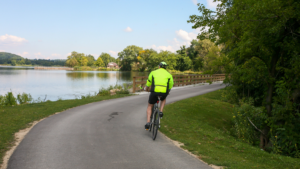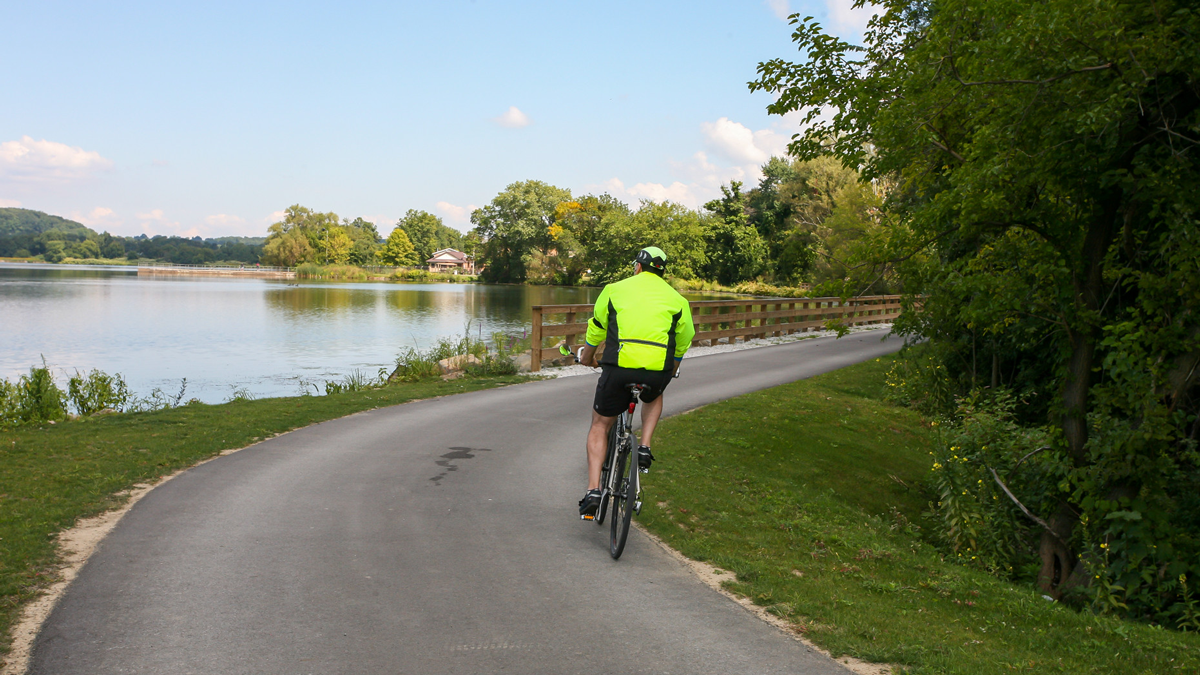
Photo courtesy of Ohio Department of Transportation.
Currently, one of the most popular federal funding sources is a program that supports transportation alternatives. Many cities and counties are launching projects using this funding that has been allocated specifically for local governmental entities. The funding program is overseen by the Federal Highway Administration.
Projects of high priority are related to recreational trails, community improvements, stormwater management, citizen safety, pedestrian and bicycle facilities and initiatives that provide opportunities to impact economic vitality. In 2023, the program will distribute over a billion dollars to state governments with a mandate to pass the funding on to public officials at the local levels of government. >
At the end of October, officials in Maryland announced the fiscal year 2023 awardees of its statewide grant program for transportation alternative projects. State grants totaling $37 million will spur the planning and design stages for 53 different projects. Other funding will be consolidated to support the projects.
The Texas Department of Transportation (TxDOT) has issued a call for funding requests to support projects that advance transportation alternatives. The agency will select eligible projects and then disburse $250 million to support them. For some project types, the amount of available funding will depend on where the projects will be sited. That’s because there are specific designated funds for rural areas as well as funding for urban regions. Active transportation infrastructure and network enhancement initiatives are two of the project types eligible for funding in all regions of the state.
This type of available funding for trails, bikeways, greenways, and other alternative transportation projects has newfound enthusiasm for tourism projects that will result in economic vitality. And resurgent support for multi-use trails has accelerated the statewide trail network’s earlier, piecemeal development.
A $20 million project in Texas is being supported by the Northeast Texas Trail organization and the initiative will stretch from Farmersville to New Boston. A former rail corridor that traverses 19 rural towns and seven counties of northeast Texas will be converted into a multimodal trail. In addition to bringing recreational tourism to an economically-disadvantaged corridor of the state, the 45 miles of trailway will include work on 10 bridges. That effort will deliver significantly improved regional mobility. This project is one of the last remaining gaps in a broader, 130-mile corridor of trailway. It will be designed for eventual integration into a nationwide network of multi-use trails.
In Multnomah County, Ore., a street project is part of a Portland metro area plan that has allocated $153 million for road, trail and sidewalk improvements. A large portion of the investment—roughly $105 million—will be used to develop travel corridors. Another $47 million will fund development of 11 projects scoped to enhance transit access, improve local trail networks and ultimately facilitate transportation alternatives. The $23 million Sandy Boulevard Complete Street Project will be launched to enhance safety, comfort and connectivity. This initiative is still in the planning phase, but it is expected to feature stormwater management, vegetative sidewalk buffers, enhanced accessibility, improved stream culverts, high-efficiency streetlights and shorter intervals between regional bike and pedestrian facilities along the route.
A federal grant of $25 million will be put to good use in Conway, Ark. It will be part of a Connect Conway project that will extend 12.5 miles across East Conway, a community that is categorized as Historically Disadvantaged. The trail will be designed to provide a safe, connected, equitable and accessible pathway for multimodal transportation. To protect non-motorized users, the greenway is planned with numerous safety-related components including rapid flashing alerts and high-intensity activated crosswalk beacons. Other projects in East Conway include a new $27 million community aquatic center and a $4 million road repair project that will connect the aquatics center to the trail network created by the Connect Conway project.
A large $68 million project in Chicago, Ill, will deliver an elevated path exclusively for pedestrians and cyclists. The multi-use trail will be constructed along a former elevated rail line and will be designed to have many common components of the iconic High Line that has been so successful in New York City. Chicago’s 1.75-mile span of elevated trailway will cross over 26 different viaducts and create nine access points for connections to the trail throughout the Englewood area. Delivery will significantly boost recreation, transportation and mobility for residents, tourists and workers in the area. Not only will the project create jobs, it will also deliver a significant boost to local economic vitality.
The Capital Region Council of Governments in Connecticut will oversee a $30.2 million project that will significantly impact the municipalities of Plainville and New Britain. The initiative will include construction of two interconnected trails to support an alternative transportation corridor. The multi-use trail will also implement innovative safety features to address citizen concerns related to 54 incidents of vehicle-pedestrian or vehicle-bicyclist collisions over the past five years. The new trails will include road diets, improved bike lanes, expansion of an adjoining central park, upgraded streetscaping and bridge repair. Once completed, the project will deliver one of the few remaining service gaps along an otherwise-cohesive 3,000 miles of trail running from Maine to Florida.
Federal funding will be used by the Kansas Department of Wildlife and Parks to launch a $27 million effort that will extend Flint Hills Trail by 40 miles. The extended trail will ultimately be one of the segments of a 118-mile trail network. The rural trail project will provide driving alternatives and deliver outdoor recreational opportunities with significant revenue-generating capacities.
These types of projects are becoming the norm throughout America. Funding is available for local entities and the only thing stopping most municipal and county officials seems to be staffing, resources and the time required for collaborative initiatives. Many public agencies throughout the country are aggressively seeking private sector involvement to help them launch these types of projects while funding is readily available.







